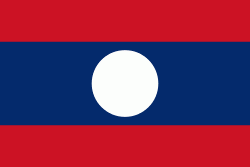Vientiane Prefecture (Vientiane Prefecture)
On a curve of the Mekong River, and bordering Thailand, the prefecture covers an area of 3920 km2. Vientiane city was built in the 16th century in the reign of King Saysethathirath. The older part of the city has ancient temples, museums, monuments and parks.
Protected areas in the prefecture include Phou Khao Khouay National Protected Area, Phou Phanang National Protected Area, and Houay Ngang Forest Reserve, a good area for bird and butterfly watching.
The prefecture is the site of the First Thai–Lao Friendship Bridge spanning the Mekong to connect with Nong Khai Province, Thailand and the New Laos National Stadium open 2009 at Route 13.
The Laotian epic, the Phra Lak Phra Lam, claims that Prince Thattaradtha founded the city when he left the legendary Lao kingdom of Muong Inthapatha Maha Nakhone because he was denied the throne in favor of his younger brother. Thattaradtha founded a city called Maha Thani Si Phan Phao on the west bank of the Mekong; this city was said to have later become today's Udon Thani, Thailand. One day, a seven-headed Naga told Thattaradtha to start a new city on the east bank of the river opposite Maha Thani Si Phan Phao. The prince called this city Chanthabuly Si Sattanakhanahud, which was said to be the predecessor of modern Vientiane.
Contrary to the Phra Lak Phra Ram, most historians believe that the city of Vientiane was an early Khmer settlement centered around a Hindu temple, which the Pha That Luang would later replace. Khmer princes ruling Say Fong were known to have made pilgrimages to the shrine near Vientiane. In the 11th and 12th centuries, the time when the Lao and Thai people are believed to have entered Southeast Asia from southern China, the few remaining Khmer in the area were either killed, removed, or assimilated into the Lao civilization, which would soon overtake the area.
In 1354, when Fa Ngum founded the kingdom of Lan Xang, Vientiane became an important administrative city, even though it was not made the capital. King Setthathirath established it as the capital of Lan Xang in 1563, to avoid a Burmese invasion. In the following several centuries Vientiane's position was not stable; at times it was strong and regional centre but often it came under the control of Vietnam, Burma, or Siam.
When Lan Xang fell apart in 1707, it became an independent Kingdom of Vientiane. In 1779, it was conquered by the Siamese general Phraya Chakri and made a vassal of Siam. When King Anouvong tried to assert himself as an independent kingdom, and raised an unsuccessful rebellion, it was obliterated by Siamese armies in 1827. The city was burned to the ground and was looted of nearly all Laotian artifacts, including Buddha statues. The Siamese routed Anouvong and razed the city leaving only Wat Si Saket in good shape. Vientiane was in ruins, depopulated, and disappearing into the forest when the French arrived in 1867. It eventually passed to French rule in 1893. It became the capital of the French protectorate of Laos in 1899. The French rebuilt the city and repaired Buddhist temples such as Pha That Luang, Haw Phra Kaew, and built colonial buildings. By a decree signed in 1900 by Governor-General Paul Doumer, the province was divided into four muang: Borikan, Patchoum, Tourakom, and Vientiane. Two years earlier, men from these four muang were responsible for building a house for the first administrator of Vientiane, Pierre Morin.
During World War II, Vientiane fell with little resistance to Japanese forces, under the command of Sako Masanori. On 9 March 1945 French paratroopers arrived, and liberated Vientiane on 24 April 1945.
As the Laotian Civil War broke out between the Royal Lao Government and the Pathet Lao, Vientiane became unstable. In August 1960, Kong Le seized the capital and insisted that Souvanna Phouma, become prime minister. In mid-December, General Phoumi then seized the capital, overthrew the Phouma government, and installed Boun Oum as prime minister. In mid-1975, Pathet Lao troops moved towards the city and US personnel began evacuating the capital. On 23 August 1975, a contingent of 50 Pathet Lao women liberated the city. On 2 December 1975, the communist party of the Pathet Lao took over Vientiane and defeated the Kingdom of Laos, thus ending the Laotian Civil War, but an insurgency in Laos began in the jungle, with the Pathet Lao fighting the Hmongs and royalists-in-exile.
Map - Vientiane Prefecture (Vientiane Prefecture)
Map
Country - Laos
 |
 |
| Flag of Laos | |
Present-day Laos traces its historic and cultural identity to Lan Xang, which existed from the 13th century to the 18th century as one of the largest kingdoms in Southeast Asia. Because of its central geographical location in Southeast Asia, the kingdom became a hub for overland trade and became wealthy economically and culturally. After a period of internal conflict, Lan Xang broke into three separate kingdoms: Luang Phrabang, Vientiane and Champasak. In 1893, the three territories came under a French protectorate and were united to form what is now known as Laos. It briefly gained independence in 1945 after Japanese occupation but was re-colonised by France until it won autonomy in 1949. Laos became independent in 1953, with a constitutional monarchy under Sisavang Vong. A post-independence civil war began, which saw the communist resistance, supported by the Soviet Union, fight against the monarchy that later came under influence of military regimes supported by the United States. After the Vietnam War ended in 1975, the communist Pathet Lao came to power, ending the civil war. Laos was then dependent on military and economic aid from the Soviet Union until its dissolution in 1991.
Currency / Language
| ISO | Currency | Symbol | Significant figures |
|---|---|---|---|
| LAK | Lao kip | â‚ | 2 |
| ISO | Language |
|---|---|
| EN | English language |
| FR | French language |
| LO | Lao language |















